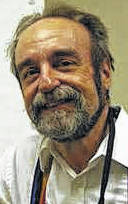
Last week, we left the Milky Way in 1953 when astronomers finally concluded that it has spiral arms.
Almost four decades earlier, Harlow Shapley had provided the pivotal evidence that our galaxy is a flattened disk surrounded by globular clusters, spheres of hundreds of thousands of stars that hover above and below the primary disk.
His assessment of the Milky Way’s size and Earth’s location has endured remarkably well for over a century: The Milky Way’s flattened disk is 100,000 light-years wide. Our Earth and sun are 26,000 light years from the disk’s center.
Since then, astronomers have made significant progress. Let’s start from the center and work our way outward.
Central Region
At the center of the Milky Way’s flattened disk is Sagittarius A*, a massive black hole surrounded by a bright, high-temperature accretion disk of hot gases being drawn into it.
At a mass of something like 4.3 million suns and a diameter of about 14.6 million miles, that black hole is bound to draw in nearby stellar material.
The Event Horizon Telescope (EHT) Collaboration recently pieced together a petabyte to produce the first image of the Sag A*’s bright accretion disk.
The disk is perhaps 35 million miles wide, about the diameter of Mercury’s orbit around the sun.
Surrounding the glowing accretion disk is a cloud of mostly dust and gas that occasionally feeds material into the black hole. Astronomers estimate its size between five and 30 light years. (One light year is about six trillion miles.)
The Central Bulge
Surrounding Sagittarius A* is a bulge of stars about 20,000 light-years wide. It consists primarily of old stars, perhaps the first to form in the galactic disk.
For decades, astronomers first assumed that the bulge was spherical, as they saw in many external “spiral” galaxies.
However, the latest results indicate that the bulge is more peanut-shaped, extending into an oval or an elongated bar with a slight bulge at the center. Astronomers call such galaxies “barred spirals.”
Galactic Bulge Extension
Above and below the galactic bulge is a thinly populated region of stars outside the galactic disk that appears to be an extension of the bulge. It is inhabited chiefly by globular clusters. It may (or may not) extend to the entire diameter of the Milky Way, with stellar populations getting less dense the farther you get from the central bulge.
The Spiral Arms
Out of the two ends of the central bar jut its primary spiral arms, the Perseus Arm and the Scutum-Centaurus Arm.
The Milky Way also sports independent minor arms and spurs emanating from the primary arms. They have been dubbed the Sagittarius Arm, the Outer Arm, and the Orion Spur. Our sun and Earth are located just outside the Orion Spur.
You can see that interpretation of the data at https://upload.wikimedia.org/wikipedia/commons/8/89/236084main_MilkyWay-full-annotated.jpg.
However, other analytic methods produce different numbers and configurations of spiral arms. The question of the Milky Way’s spiral structure is far from settled.
The spiral arms appear to be slightly warped. It’s as if you grabbed and slightly twisted one of those plastic flying disks. What could be causing the twist? It might be …
The Outer Halo
Extending well beyond the primary disk’s diameter is a massive halo of material exterior to the visible disk. Astronomers inferred its existence from its gravitational effect on the stars at the ends of the spiral arms. It extends to at least a spherical diameter of 150,000 light years.
Since its material can be detected only indirectly, astronomers speculate that it is primarily composed of dark matter.
Astronomers estimate that the halo is at least several times more massive than the visible disk of the Milky Way. Our galaxy is likely made up of more matter that we can’t see than matter that we can.
To summarize: The Milky Way is a rotating, barred-spiral galaxy about 100,000 light-years wide. Earth is located about 26,000 miles from its center in or near one of its spiral arms. But we don’t yet really know for sure.
The sun and Earth are firmly inside the galactic disk’s enormity, making it problematic to get outside and take measurements.
Only about 1% of the Milky Way’s stars have been surveyed for distance and motion. The Milky Way’s total mass consists primarily of dark matter, which we cannot study directly. Interstellar dust obscures the view of much of the galaxy.
As astronomer Eleonora Zari said, “It’s like being in a forest and looking around. At some point, the trees are in front of each other. Plus, the forest is a bit foggy, so you really can’t see what the whole forest looks like.”
The ancient search for the Milky Way’s nature began millennia ago with a stream of milk spilled across the sky. That quest goes on.
Tom Burns is the former director of the Perkins Observatory in Delaware.

